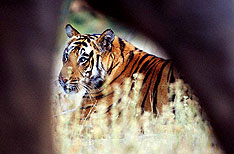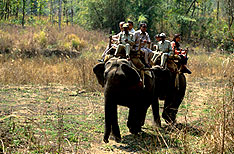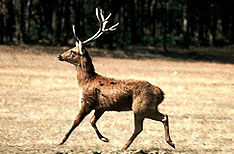 |
  Home | Contact | Site Map |

| Top Destinations |
|
You are here Home » Top Destinations » Manas National Park Assam
Honeymoon in Manas National Park, Assam, India  About Manas National Park Manas Tiger Reserve, situated amidst the gentle slopes at the foothills of the Himalayas in India's northeastern state of Assam, is the only tiger reserve of its kind in the entire northeast. Apart from the rising population of tigers, Manas is also the home of the rare golden langur, the hispid hare, the pigmy hog, the one-horned rhinoceros and at least twenty other species of animals and birds that are listed as highly endangered. Manas derives its name from the Goddess Manasa. The forest stretches beyond Indian territory to the Himalayan kingdom of Bhutan, with the crystal waters of the Manas River demarcating the international border. Some areas that adjoin the river path are often flooded, but only for a brief period; the water level subsides as soon as the rainfall stops because of the sloping. Mixed deciduous type of vegetation is found in the park. The dense forest cover often prevents the sunrays from the forest. This beautiful park was previously known as North Kamrup and was declared a sanctuary on October 1, 1928, with parts of it having been notified as reserved forests as early as 1907 and 1927. It was established as the core of the Manas Tiger Reserve from April 1973 and consecutively inscribed on the World Heritage List in 1985 and elevated to the position of a National Park status on September 7, 1990. HISTORYManas Tiger Reserve was created in 1973, with Manas Sanctuary as its core. Manas Sanctuary with an area of 360 sq. km., was created way back in 1928. Prior to the declaration setting up the sanctuary, the area was a Reserved Forest (R.F.) called Manas R.F. and North Kamrup R.F. The Raja of Gauripur and the Cooch-Behar royal family were using these areas as a hunting preserve. Later, the sanctuary was extended by two successive additions, in 1951 and 1955, to 391 sq. km. by including the entire North Kamrup R.F. and the Manas R.F. Subsequently, the Kahitama R.F., the Kokilabari R.F. and the Panbari R.F. were added and the area was declared as Manas National Park 1990. TRAVELLING IN THE WILDSMake a trip through the gravel road from Barpeta to Manas National Park during the wee hours of the morning or late in the evening. Drive past the Bansbari tea estate and as you enter the open grassland, look out for the extremely rare species of the hispid hare. This is an elusive rabbit-like animal, about 47 centimetres in length. The back and the tail are dark brown and the breast is whitish in colour. After a sharp turn, you might find an extremely alert pair staring directly into the headlights of your jeep. WILDLIFEManas National Park enjoys a very special status in terms of wildlife in the sub continent for two reasons: it has a much longer visiting season and it is home to twenty-two of the sub-continent?s fifty-four endangered species. Some like the hispid hare and pigmy hog are found only here. Yet, unlike in Kaziranga, where sightings are very common because of open spaces and swamps, in Manas a visitor may not come across too many animals. By taking up a holiday trip to Manas national park to sight the wild at such close quarters that often the visitor is left spell bound. SAFARISThe Jeep, Elephant and Boat RidesThe ideal way to explore a majority of the Manas National Park in Assam is in a 4-wheel (Jeep) drive petrol vehicle. The Jeep ride will get you to all the corners of the Manas Park without being too noisy. Some of the animals that comes out on the banks of the river Manas can be viewed from a boat which commences its ride from Mathanguri and ends around 35km away, from where one is picked up by pre-arranged transport. The third option, which are a favourite with most visitors, are the elephant rides organised by the park authorities from Mathanguri. These take you deep in to the densest areas of the forest and often right in between some of the wildlife there, including elephants, rhinos and wild buffaloes. FLORAThe vegetation that covers most of the park is of the mixed deciduous variety. This mixed forest is intermixed by small glades of grass where deer can be seen grazing in huge numbers. Altogether, Manas National Park Assam offers some of the most eye-pleasing natural surroundings in the country. FAUNAThe animal population of Manas National Park Assam is very diverse. Some of the more fierce or potentially aggressive creatures it holds within it's confines are Tigers, Elephants, Rhinos, Wild Buffaloes, Leopards, Clouded Leopards and the amazingly beautiful and rare Black Panthers. The park is also a haven for highly endangered species of which it houses 20. Two of the unique residents of the park are the Hispid Hare and the Pygmy Hog. Some of the other animals sighted while exploring the park are Gaurs, Swamp Deer, Capped Langurs, Golden Langurs, Assamese Macaques, Slow Loris, Hoolock Gibbons, Smooth Indian Otters, Sloth Bears, Barking Deer, Hog Deer, Sambar and Chital. THE AVIFAUNAManas National Park in Assam is a favourite with many bird species, resident and migratory. Some of these are Giant Hornbills, Jungle Fowls, Bulbuls, Brahminy Ducks, Khaleej Pheasants, Egrets, Pelicans, Fishing Eagles, Serpent Eagles, Falcons, Scarlet Minivets, Bee-Eaters, Magpie Robins, Pied Hornbills, Gray Hornbills, Mergansers, Harriers, Ospreys and Herons. EATING PLACESIf you are staying outside the main park at either Barpeta Road or Bansbari, finding places to eat is not really an issue worth worrying about. But if you make arrangements for your stay at Mathanguri inside the park, it is necessary to go prepared with all the rations and necessities that would be required. If cooking is a problem, the forest guard or caretaker at the rest house doubles up as a cook and can be given the necessary instructions along with the rations. Please remember that this is not really a part of his job and a decent tip at the end of your stay in appreciation of his services would be a nice gesture. VEGETATION AND TOPOGRAPHYThe vegetation that covers most of the park is of the mixed deciduous variety. This mixed forest is interspersed by small glades of grass where deer can be seen grazing in large numbers. The topography of the park is mainly small meadows located among thickly forested foothills with many rivulets, streams and natural drains flowing all over. The park is mainly drained by the river Manas, which also forms the international boundary between India and Bhutan. In the lower reaches, there are many smooth sandy stretches with clumps of trees growing in, and around, them. In general, Manas offers some of the most pleasing to the eye natural surroundings in the country. General Information of Manas National Park LOCATIONManas Tiger Reserve, situated amidst the gentle slopes at the foothills of the Himalayas in India's northeastern state of Assam, is the only tiger reserve of its kind in the entire northeast. How to Reach By AirManas Park is 176-kms from Guwahati. The nearest airport is Borjhar, which is situated, 5-km out of town, and can be reached by rickshaw, auto rickshaw or airline buses. By RailThe nearest railhead is situated at Barpeta road. By RoadBuses regularly ply from Guwahati to Barpeta Road in 41 hrs. CLIMATEThe climate of Manas park is tropical. the Summers are hot and winters cold. Take cotton cloths for summers and do not forget to pack woolens during winters. The average rainfall is 160 cms. But the monsoon months bring heavy downpours which often flood the park. BEST TIME TO VISITThe climate of Manas Tiger Reserve is tropical. The temperature during summer does not rise above 37?C and during the winter it stays at around 11?C. Monsoon season (May-September) brings heavy to very heavy rainfall to the tune of 160 cm, because of which the park often gets flooded. Tourist Attractions IN Manas National Park
For those interested in big mammals, Manas National Park has a deep pocket. It has a considerable population of rhinos (although much less in numbers than in Kaziranga), elephants, wild buffaloes, gaurs, swamp deer, sambar, hog deer and barking deer. Besides these animals, cats form a sizeable group in the Park. Going by the last count, there were 80 tigers, clouded leopards and golden cats. Inspite of such a large number of tigers, sightings are very difficult and sometimes possible due to sheer happenstance. Wild Buffaloes make an interesting subject for photography, but take care while shooting, as the animal is quite weary and can attack without any provocation. In fact, wild buffaloes are known to drive even tigers away. |
 Another species that deserves a special mention is the golden langur. This beautiful animal is 48 to 50 centimetres in length and the tail adds another 75 centimetres to it. The colour of its coat changes with each season. During winters, when the body needs to absorb more heat, the colour of the coat is light golden or deep yellow. It gradually changes to off-white as the hot summer months are round the corner. The face, however, remains black all through the year.
Another species that deserves a special mention is the golden langur. This beautiful animal is 48 to 50 centimetres in length and the tail adds another 75 centimetres to it. The colour of its coat changes with each season. During winters, when the body needs to absorb more heat, the colour of the coat is light golden or deep yellow. It gradually changes to off-white as the hot summer months are round the corner. The face, however, remains black all through the year.